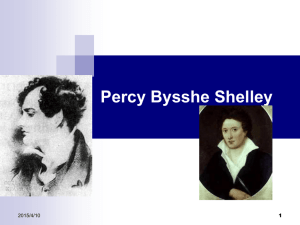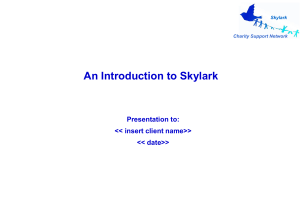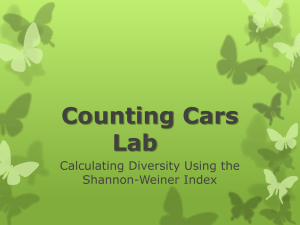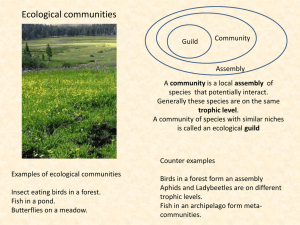Landscape complexity – and its effects on population
advertisement
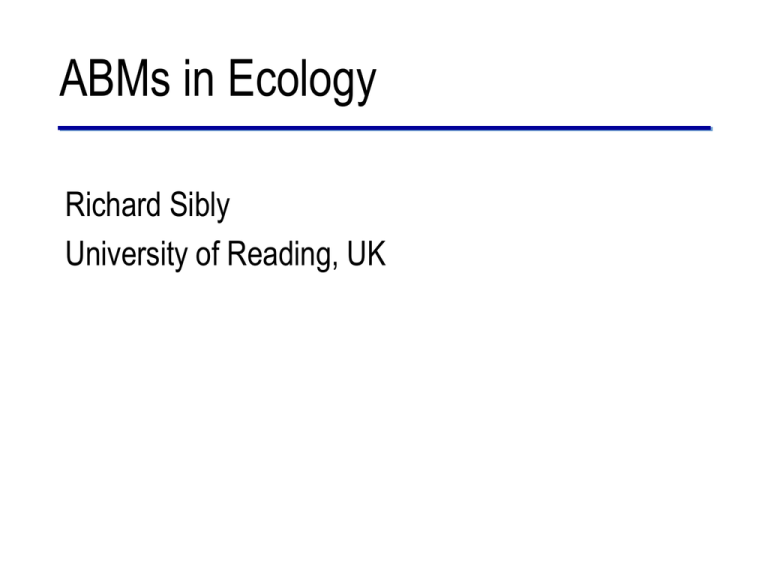
ABMs in Ecology Richard Sibly University of Reading, UK Risk assessment of chemicals Ecological risk assessment in the EU aims to protect populations rather than individuals* *European Commission, 2000. Guidance Document on Terrestrial Ecotoxicology: Directorate General for Agriculture. Classical models of population dynamics • Population dynamics is the study changes in population numbers over time • Why do numbers change? Classical models of population dynamics birth rate death rate population density population density population growth rate = birth rate – death rate How to measure population growth rate population growth rate = birth rate – death rate =r Euler-Lotka equation Classical models of population dynamics birth rate death rate population density population density population growth rate = birth rate – death rate population density population growth rate population density Number of Paramecium/mL Logistic population growth 1,000 800 600 400 200 0 0 5 10 15 Time (days) A Paramecium population in the lab Both density and chemicals affect pgr population growth rate population growth rate population density dose of chemical Both density and chemicals affect pgr population density birth rate population growth rate dose of chemical death rate Population Size (N) How stress affects population growth Baseline A AR ARx2 10000 7500 5000 2500 0 0 50 100 Simulation Year 150 200 York workshop 2004 Population risk assessment of birds and mammals in the UK The York approach: five steps to population risk assessment • toxicity endpoints in the lab • extrapolate between species • assess exposure in the field • extrapolate from lab to field • evaluate effects on populations of skylarks and woodmice With Insecticide Time Skylark abundance g) No Insecticide Skylark abundance f) Time Broad Habitats Time Time Broad Habitats h) With Insecticide Skylark abundance Time Winter Wheat Skylark abundance No Insecticide Skylark abundance e) Skylark abundance Skylark abundance Skylark abundance Time Winter Wheat Time Time Agent-based model (ABM) of Chris Topping Spatially explicit model of animal behaviour of the vole The study landscape Real 10x10 km Danish landscape by Bjerringbro, 1-m resolution Legend Main road Roadside verge Permanent grass Unmanaged grassland Rotational field (same colours for all crops) Coniferous forest Deciduous forest c) BEHAVIORAL STATE FM = FINDING MATE F M Agent specification D Y Is it past breeding date (June 19th)? YES Is it past covey hopping time (June 1st)? NO YES NO Are coveys within 500m of you? NO Are you visiting some other covey? NO Are you in a new covey now? YES Jump to a new covey FL NO YES Leave the covey Fly to a new area YES Revoke visitors pass NO Join this covey YES Find Mate in area (500 m2) Make your covey FM G M Did you find mate in new covey? YES Does your mate have a territory? YES NO FO M Did you find mate in your search area? NO Agent-based model (ABM) Spatially explicit model of animal behaviour of the vole Population dynamics emerge as result of local interactions Dynamic landscape with crop rotation and weather-dependent plant growth Time Skylark Time Skylark abundance d) Time Time h) Skylark abundance Time With Insecticide Broad Habitats With Insecticide Time g) Skylark abundance Time c) Time f) Skylark abundance e) Broad Habitats No Insecticide h) Skylark abundance Time No Insecticide Skylark abundance Winter Wheat With Insecticide g) Time Broad Habitats Skylark abundance b) With Insecticide Time Broad Habitats Skylark abundance Time f) Skylark abundance Winter Wheat No Insecticide Skylark abundance a) No Insecticide Time Winter Wheat Skylark abundance Skylark abundance e) Skylark Skylark Skylark Time Winter Wheat Time Time ABM vs. Classical methods • ABM can be parameterised • Classical models cannot be parameterised • ABM is complex • Classical models are very simple Sibly, R.M., Akçakaya, H.R., Topping, C.J., O'Connor, R.J. (2005) Population-level assessment of risks of pesticides to birds and mammals in the UK. Ecotoxicology, 14, 863-876. Topping C.J., Sibly R.M., Akçakaya H.R., Smith G.C., Crocker, D.R. (2005) Comparison of a life-history model and an individual-based landscape model of skylark populations affected by a pesticide. Ecotoxicology, 14, 925-936. Volker Grimm Helmholtz Center for Environmental Research, Leipzig • Grimm, V., and Railsback, S.F., 2005. Individual-Based Modeling and Ecology. Princeton University Press • Grimm, V. et al. 2005. Pattern-oriented modeling of agent-based complex systems. Science 310, 987-991. CREAM 20 PhD (three years) and 3 postdoc (two years) projects developing ecological models for the risk assessment of chemicals http://cream-itn.eu/ started 2010 funded by EC CREAM questions 1) Can we make credible ABMs that will be accepted by Risk Managers Risk Assessors Scientists 2) How do we Verify Validate these models? CREAM methods • Chemical – fictitious pesticide • ABMs using Netlogo to model application of chemical, exposure of individuals and effects on individuals • Validation: data sets exist for Danish landscapes in northern Jutland for skylark and vole. For woodpigeon, data sets from ITE Monks Wood. Validation Grant applied for by Mark Beaumont: “Bayesian Inference in Agent-Based Modelling” Classical evaluation of models • Model: y = a + b1x1 + b2x2 + b3x3 + … + ε • Some information is known – some values of y, x1, x2, x3. The values of b1, b2, b3 are estimated from the data. • Evaluation is by calculating R2, the % variance in the y values that is accounted for by the model. Bayesian evaluation of models • Model: ABM predicting population numbers over years • Some information is known but some parameter values are estimated from the data. • Evaluation is by calculating the likelihood of the model given the data. Bayesian vs classical • When both methods can be applied they give the same results. • Bayesian can handle ABMs but classical cannot. • Classical methods are faster and well established so easier. Short history of Bayesian methods • MCMC widely used since computers got faster c.1990. • MCMC requires likelihood function. But, we cannot derive likelihood function for ABMs. • Since 2002 Approximate Bayesian Computation (ABC) avoids need to derive likelihood. Also, can use parallel computation and far fewer runs than MCMC. So ABC makes ABM evaluation feasible. Evaluation of models using ABC • ABC calculates posterior probability of each model given the data. • The model with the higher probability is better. • The ratio of probabilities is called the Bayes factor. • Bayes factor = 10 means one is 10 times more likely than the other. Example of ABC • Tomasz Kułakowski produced a skylark ABM in Netlogo starting February 2010 • 900 lines of code • ABC on 24 parallel processors, 1 h per run, 1000 runs takes 2 days Data for skylarks in study area • • • • 20% eggs predated per year 10% eggs die other causes 8% nestlings predated per year 10% nestlings die other causes Model parameters • Predation parameter • Deaths other causes parameter Prior distributions Predation parameter of model parameters Other causes parameter Posterior distributions of model parameters Predation parameter Other causes parameter How does ABC do that? • Runs model 1000 times with parameters chosen from priors • Retains 10% giving closest match to data 20% eggs predated per year 10% eggs die other causes 8% nestlings predated per year 10% nestlings die other causes How does ABC do that? eggs predated per year egg deaths other causes nestlings predated per year nestling deaths other causes Prior distributions Predation parameter of model parameters Other causes parameter Posterior distributions of model parameters Predation parameter Other causes parameter Bayesian evaluation of models • Model: ABM predicting population numbers over years • Some information is known but some parameter values are estimated from the data. • Evaluation is by calculating the likelihood of the model given the data. Summary • ABMs promise realistic models of animal populations in real landscapes. • Major issue is validation • ABC offers method of validation Sottoriva, A., and S. Tavare. 2010. Integrating approximate Bayesian computation with complex agent-based models for cancer research. In: Saporta, G., and Y. Lechevallie, editors, COMPSTAT 2010: Proceedings in Computational Statistics. Springer, Physica Verlag. In Press. Beaumont, M. 2010. Approximate Bayesian Computation in Evolution and Ecology. Ann. Rev. Ecol. Evol. & Syst. In Press. Acknowledgements • • • • Chris Topping, University of Aarhus Mark Beaumont, University of Bristol Chris Greenough, Rutherford Appleton Laboratory Jacob Nabe-Nielsen, University of Aarhus • • • • Tomasz Kułakowski Katarzyna Matuszewska Trine Dalqvist Chun Liu
